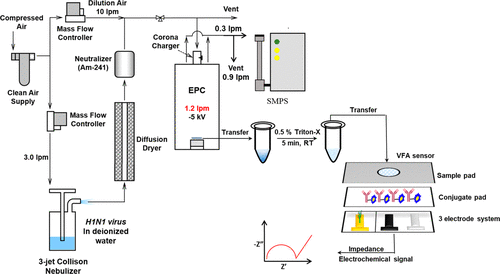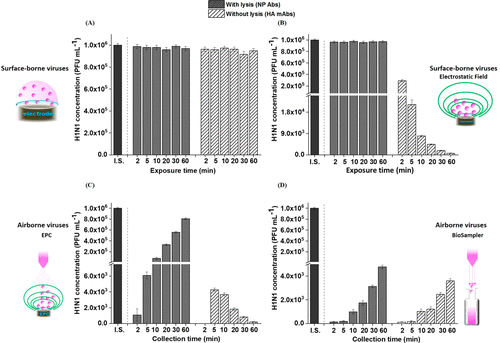A novel technology, capable of detecting the amount of airborne infectious influenza virus in the environment, such as coronaviruses and flue viruses, has been developd. This is expected to be of great help in the public safety and medical fields.
A research team, led by Professor Jaesung Jang in the Department of Mechanical Engineering at UNIST has developed a paper-based immunosensor that rapidly quantifies the influenza viruses in air after sampling with a portable electrostatic particle concentrator (EPC). The new system has been confirmed to be effective in collecting the respiratory droplets that travel through the air, as well as the infectious particles even smaller than 1 μm. Moreover, because these sensors can provide rapid detection without damaging the viruses to be collected, the level of measurement accuracy for the system is also high.

Figure 2. Schematic of experimental setup: bioaerosol generation and concentration using the electrostatic personal concentrator (EPC), transfer to the paper sensor, and electrochemical measurement using vertical flow assay (VFA)-based immunosensors.
In order to facilitate the rapid detection of viruses with high degree of precision, we need an air-sampler that safely collects the influenza virus particles in air, along with a sensor that rapidly detects the virus. However, the currently available virus detection methods collect viruses in a way very similar to how a vacuum cleaner works. As a result, the collected viruses may be subjected to structural damage ansiccation during the process. In addition, in the case of conventional PCR testing (also known as polymerase chain reaction tesing), it suffers from major disadvantages, like time-consuming post-PCR handling.
In this study, the research team has fabricated vertical-flow-assay-based electrochemical paper immunosensors to rapidly quantify the influenza viruses in air after sampling with the EPC. According to the research team, the new sytem is capable of collecting and detecting viruses with particle size below 1 µm or even above 10 µm. Moreover, the damage to the viruses that may occur during collection process can be minimized, as well.

Figure 2. Effects of different collection conditions on the detection of influenza viruses using HA-mAb and NP-mAb with respect to exposure or collection durations (2–60 min) for (A) no aerosol generation and no electrostatic field, (B) only electrostatic field without corona charging, (C) aerosol generation with electrostatic field and corona charging, and (D) aerosol sampling with the BioSampler.
Using this paper sensors with the EPC, the research team has demonstrated the rapid quantification of airborne influenza A H1N1 viruses. According to the research team, the new system provided measurements comparable to quantitative polymerase chain reaction (qPCR) but much quicker, specific to the influenza H1N1 viruses in the presence of other airborne microorganisms and beads, and more cost-effective than enzyme-linked immunosorbent assay and qPCR. Besides, it also showed a much higher virus collection efficiency for antigen–antibody reaction, when compared to the existing immunosensors. Furthermore, the system could even detect the smallest amount of airborne viruses that are common during flu seasons.
The findings of this research have been published online in the August 2020 issue of Environmental Science & Technology. This research has been supported by the National Research Foundation of Korea (NRF) and the Ministry of Science, and ICT (MSIT).
Journal Reference
Jyoti Bhardwaj, Myeong-Woo Kim, and Jaesung Jang, “Rapid Airborne Influenza Virus Quantification Using an Antibody-Based Electrochemical Paper Sensor and Electrostatic Particle Concentrator,” Environ. Sci. Technol. (2020)












